#where are the missing indigenous women and girls
Text
What will they do when it's their kids that need life-saving medical care? What will they do when it's their kids that will kill themselves, hurt themselves, ruin their future because 'what is living for if they'll never be happy'?
What will they do when their daughters are touched and forced to have children at 13. At 12. At 9? When their wives die of complications and the "baby" they tried to save dies with them? Or that fetus actually grows into a baby. What then? Are you just going to raise children without their mothers when you knew damn well that having a kid would kill those women?
They'd rather put their families in body bags. They'll put our families in body bags. They ARE putting our families in body bags. Our families, friends, neighbors are going "missing".
Indigenous women are going missing left right and centre and absolutely no one is looking for them. They are being killed. Raped. Sterilized. Without consequence. They started with them and no one batted an eye. And now they're coming for us. For all of us.
White women will be forced to have children (oh but only cishet children because otherwise that kid dies). Everyone else will be sterilized in a quiet genocide. Or if the Proud Boys and their employers have their way, a violent and loud genocide. A holocaust in the proud "Land of The Free".
Who is this "they"? Council of National Policy. A white Christian nationalist group that have been behind all the steps back in legislature for the last couple decades. And they're the ones behind the current hundreds of transphobic bills hitting the courts, senate and house right now through their offshoot organizations.
You want to kill the Hydra? Let's cut off the main head.
#inclusive feminism#intersectional feminism#trans rights#transphobia#Council of National Policy#protect trans kids#tw rape#tw genocide#tw fascism#where are the missing indigenous women and girls#where are their sisters#where are their mothers#where are their feiends#where are their wives#WHERE ARE THEY#US policy#us politics#United States of Genocide#our fucking country was built on genocide and slavery and WE'RE DOING THIS AGAIN#everyone I love will fucking die#i'll never marry my girlfriend#abortion#tw child birth
6 notes
·
View notes
Text
It's important to recognise that what's happening in Palestine, what we are witnessing and what people are experiencing, are not isolated to Palestine.
You may hear people talk about the war in Sudan, the silent holocaust in Congo.
It's because these and so many more atrocities in the world are linked. They are preperuated by the same systems.
[Video Transcript:
So as a Palestinian when I say Free Palestine, I am not just talking about Palestine. I started nursing school in 2015 at Saint Louis, just a few miles away from where Michael Brown was killed by police.
Being in that city at that time, watching Black Lives Matter being born, stirred up a lot of feelings for me as a Palestinian.
I saw a country justifying a child being murdered by the state, in the street. I saw the people protesting that murder being vilified.
Standing there, protesting, watching a militarised police force with tear gas and rubber bullets matching towards me.
And I thought, this is that.
As a Palestinian to understand what is going on in Palestine is to understand the de facto aphartied that black Americans experience here in the states.
It's not an accident that when my grandfather came here, he was told to sit and the back of the bus. And it's not an accident that he marched with MLK.
It has been black and Palestinian solidarity, and it continues to be black and Palestinian solidarity.
Because yes, Free Palestine is about Palestine ceasefire now and the military occupation of the Palestinian people. It's also about resisting the global colonial hegemonic structure.
Because the shit happening there is happening here. If it isn't Palestinian women and babies being killed by bombs in Gaza, it's black women and babies being killed in American hospitals.
If its not Palestinian girls missing in the rubble. It is missing and murdered indigenous women here in the United States.
The rage I feel when I hear the names Michael Brown and Treyvon Martin is the same rage I feel when I hear the names Shireen Abu Akleh and Ahmad Manasra.
That's not to say that allyship is transactional, it is to say that the only thing we have is each other.
There's a reason that when people ask me about Free Palestine, I will point them to books on Black Lives matter.
When I say Free Palestine, yes I mean Free Palestine but I also mean Black Lives Matter, I also mean abolition now. I also mean reparations, I also mean land back.
This movement cannot lose steam, not just because there is currently a genocide being perpetuated against my people. And every minute we don't do something Palestinian lives are being lost.
But because this is a global struggle for justice. It does not start and end with Palestine, we will not be free until all of us are free.
The world is waking up, there has never been global solidarity for Palestine like this.
And we have them so scared. The violence is so disproportional because we are challenging a global power structure. Don't let the momentum die because this is about all of us.
Ceasefire now.
End the occupation.
But know what I mean when I say, Free Palestine.
End Transcript.]
Books shown in the video:
"When they call you a terrorist a black lives matter memoir" by Patrisse Khan-Cullors & asha bandele.
"Freedom is a constant struggle. Ferguson, Palestine and the foundations of a movement" by Angela Y. Davis
#free palestine#free gaza#black lives matter#usa#us#america#indigenous people#native american#free sudan#free congo#blm#human rights
1K notes
·
View notes
Text
Nesta, Interrupted: gendered perceptions of alcoholism in ACOSF
CW: addiction, sexual assault, gendered violence.
Creds: I’m a licensed counselor with a degree specialization in treating addiction. I have career experience with multiple modes of mental health, trauma, and substance use treatment in women-specific carceral, institutional, and healthcare settings. And I know anyone can come on the internet and say that, but I pinky promise.
The short version:
ACOSF stigmatizes alcoholism in line with cultural standards.
Western culture feels differently about female and male alcoholics due to systemic sexism, and thus treats them differently.
Women’s experience of alcoholism is often compounded by or even a result of systemic factors and intersectional identity.
Nesta’s treatment in ACOSF, while repugnant, is in many ways very accurate of attitudes today.
(I’ll be using “women/men” and “male/female” to denote cis afab and amab people. Little research exists on the experiences of queer, nonbinary and gender expansive considerations in addiction and recovery, which is a fuckin’ shame. Studies are also largely conducted with white participants due to enormous barriers to treatment for Black, Indigenous, and people of color, so this convo is inherently incomplete where it neglects those intersections.)
Okay, first things first: ACOSF is a book that stigmatizes alcoholism. I will not be taking questions.
The number one thing to understand is that in America, land of Miss Sarah, we are very bad at addiction treatment (tx). Why? Because our culture hates addicts has as stigma around addiction. And female alcoholics bear a very specific set of stigmas based in their identity.
In Susanna Kaysen’s memoir Girl, Interrupted , Kaysen’s character is institutionalized following a non-fatal suicide attempt. When evaluated, she’s diagnosed with borderline personality disorder, that bastion of diagnoses perfect for people (75% of whom are female-identified) who don’t fit into our polite definition of functioning. As the book unfolds, she reflects on how (white) women are often pathologized when they buck against systems of oppression that create the dysfunction in them in the first place. That is not to say other women in the institution are not genuinely in need of help, nor that mental illness in women is always from a systemic wound. But it’s crucial in the treatment of female addiction and mental health disorders to considered the systemic factors of gendered violence and patriarchy, and the attitudes we hold about women who struggle with drinking.
Think about female alcoholics in media. If she’s young, she’s a loose, reckless sl*t looking for trouble and deserving of the reality check when she finds it (Amy Schumer in Trainwreck, Lindsay Lohan in general). Or if the woman are older, they are discarded, or gross, or pathetic, or evil like anyone Faye Dunaway played or Eminem’s mom in 8 Mile (deep cut lol). Men are afforded a much larger spectrum of experiences and struggles - Ernest Hemingway, Leaving Las Vegas, Sideways, the dude from A Star is Born, Frank from Shameless (brilliant), frat boys, blue collar workers, introspective tortured artists, fucking IRON MAN. I could go on forever, but I hope that illustrates the depth and diversity of male-centric stories of alcoholism not often afforded to women.
One of the most empathetic and accurate portrayals of female alcoholism, in my opinion, is in the show Sharp Objects (the book, too, but actually witnessing it makes a difference). We see Amy Adams’ Camille swig vodka from an Evian bottle while fending off vicious, veiled attacks from her verbally and emotionally abusive mother and experiencing flashbacks of teenage sexual assault. We watch her struggle to find emotional safety in her conservative hometown, both wanting to fit in and get out in order to survive. We GET why she drinks and I have trouble blaming her for it even as she wreaks havoc on herself and others. We can see her clawing just to make it out alive, and alcohol is the tool she’s using to do it, for better or worse.
Which is where Nesta enters the chat. When we get our first glimpse of her alcohol use is ACOFAS, it’s portrayed as something everyone knows about but that she’s still mostly keeping it together - her dress is clean, her hair is neatly braided, she doesn’t need a chaperone to show up to a family event. The deterioration between ACOFAS and ACOSF is alarming, and we know that alcoholism is a progressive condition so that tends to happen. Was there a particular trigger? That’s hard to say. Solstice certainly didn’t help, especially with the pressures to perform and conform to the standards of the Inner Circle aka the people in power. I imagine seeing her sisters bouncey and reveling in the world that stole them and killed their father was probably.. tough, to say the least. The barge party seems to be a turning point as well, though this one is more confusing to me. But given the child abuse, extreme poverty, sexual assault, kidnapping, bodily violation, witnessing her father’s murder, almost dying, WAR - and that’s not even to mention essentially becoming a refugee - it would be amazing if she DIDN’T drink. She 100% has complex trauma, and is looking for ways to cope.
No one with full capacity dreams of becoming an addict when they grow up. Addiction, in my professional and personal experience, is largely a strategy for coping with a deeper wound. People don’t drink to feel bad. They drink to feel good, and to survive. Nesta herself is drinking to survive, but it’s having the unfortunate side effect of killing her at the same time. As she slides into active addiction, the thought of her own death may even be comforting, and alcohol in that way is her friend. (There's some interesting research right now framing addiction as an attachment disorder, but I don't know enough to speak on it much.)
So she obviously needs help. That’s not a debate. What is a debate is how the IC should best go about intervening. A variation on the Johnson method is used in ACOSF (the one from the show Intervention) and appears to be successful only because they threaten her if she doesn’t comply. This method has mixed data to support it, and while it’s very good at getting people into tx, there is a higher relapse rate for those who receive it (1). The “family” gathers and tells her the ways she’s hurt them and tell her the consequences if she doesn’t seek the help they’re offering. And again, so many of their reason are the effects on THEM, how she’s making THEM look, not her pain.
The IC’s ignorance and dismissal of her alcoholism in ACOSF is frankly mystifying. Why do they intervene on all the drinking and sexing, anyway? It seems like they’ve been fine enough with it up to this point. But now it's gone too far, not because of her illness but because she is embarrassing them. And I don’t know about you, but between Cassian apparently fucking half of Velaris and Mor’s heavily documented emotional drinking, that’s hard to square. It makes it feel much more likely that they don’t like the way she is coping, that she is not fitting into their picture of who she’s supposed to be. This picture is inherently gendered, because Prythian society and those who live in it have explicit and implicit expectations of gender roles, whether they’ll admit it or not. Cassian and Mor are playing their roles well; Nesta is not.
That leads me to believe it is NOT all about her, but the systemic and internal factors influencing their perception of her and the ways she’s struggling. It’s distasteful to them for her, a female, to be deteriorating this publicly, despite the fact that her very identity makes it harder for her to function in the patriarchy of Prythian. We hear almost exclusively about sexual violence against women, aside from 2 male characters. Past or present assault of women is a major plot point on multiple occasions (Mor, Gwyn, Nesta, Emerie, Rhysands mom and sister, the lady of autumn, Cassians mom, Azriels mom, I could go on). But something about the way Nesta is contending with that is unacceptable, and I believe it’s because she’s not trying to cover up her dysfunction. In prythian, we keep these things hidden- Mor’s assault is never processed in full, Azriel’s mom seems to be alone at Rosehall, priestesses are literally hidden inside a mountain for centuries. Women process trauma alone and in the dark, but Nesta is in the light and she is loud. She is refusing to hide her problems, and the IC don’t like that, whether they realize it or not.
So why don’t the IC understand this? Like I said earlier, as a culture we hate addicts, or what they stand for, in very much the same way I think we hate people experiencing homelessness. We convince ourselves it was a series of bad choices that led someone where they are, choices we would never make because we are smart, smarter than them. We believe are more in control than that. We can prevent bad things from happening to us because we are good, because we are better than whoever it’s happening to. But the reality is almost ALL of us are one hospital stay away from homelessness, just as all of us are one trauma away from addiction. And with female addicts, we have another layer of expecting women to only struggle nicely and quietly, or to go away. Intersectional factors are at play here, too: white women are much more likely to have alcoholism attributed to mental health and trauma factors, where people of color often suffer the same addiction being more associated with crime. You can imagine how that plays out differently.
So what is the effect of all this? Gendered expectations lead to not only external stigma around addiction and tx, but also to internalized stigma which can limit willingness to seek tx. (2) Many social forces encourage women to drink and discourage them from telling anyone. Factors such as poverty, family planning, access to education, racial discrimination, and location can make services harder to access. Internally, women are more likely to enter treatment with less confidence in their ability to succeed, but report more strengths and more potential to grow recovery strengths during and following tx. For men, the pattern is reversed (3). And women have more successful tx episodes overall when gendered considerations are a part of the design and implementation of services (4). For Nesta, the effect is that she’s forced into treatment and copes by having hate sex with her ex and changing herself to conform to her family’s expectations while the House and the Valkyrie’s actually take care of her. I do not see how Sarah drew the line from there to recovery, I truly don’t. If anything, she recovers in spite of the ICs intervention, not because of it.
In summary, Nesta Archeron deserved better. Nesta deserved the same compassion the book gives to men who are struggling, and it’s a reflection of not just the book’s culture but the author’s culture that she doesn’t get it. Female alcoholics are worthy of treatment that integrates their identities, as those identities are often essential factors contributing to their addiction. What's shown in ACOSF is a reality many women live, and they shouldn't have to.
Barry Loneck, James A. Garrett & Steven M Banks (1996) The Johnson Intervention and Relapse During Outpatient Treatment, The American Journal of Drug and Alcohol Abuse, 22:3, 363-375, DOI: 10.3109/00952999609001665
Groshkova T, Best D, White W. The Assessment of Recovery Capital: Properties and psychometrics of a measure of addiction recovery strengths. Drug Alcohol Rev. 2013;32(2):187–94.
Best D, Vanderplasschen W, Nisic M. Measuring capital in active addiction and recovery: the development of the strengths and barriers recovery scale (SABRS). Subst Abuse Treat, Prev Policy. 2020;15(1):1–8.
Polak, K., Haug, N.A., Drachenberg, H.E. et al. Gender Considerations in Addiction: Implications for Treatment. Curr Treat Options Psych 2, 326–338 (2015). https://doi.org/10.1007/s40501-015-0054-5
#nesta archeron#pro nesta#alcoholism#mental health#sexism#acotar#acosf#stigma#rehabilitation#prythian university#sjm critical
140 notes
·
View notes
Text
On Greta Danesti...
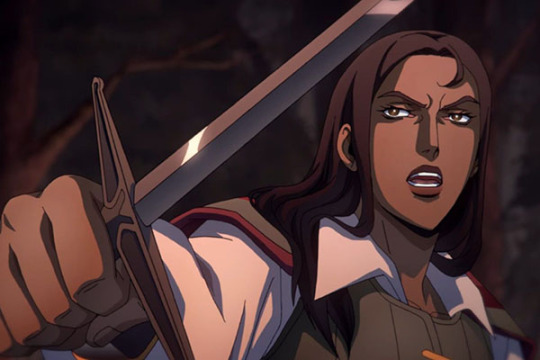
I'm just taking this time to correct a certain anti-Black, (and anti-Romani) sadly typical fandom troll's misogynoir fuckery in the tag and establishing who Greta Danesti is in canon Castlevania animation lore.
This is Greta Danesti's official character sheet:
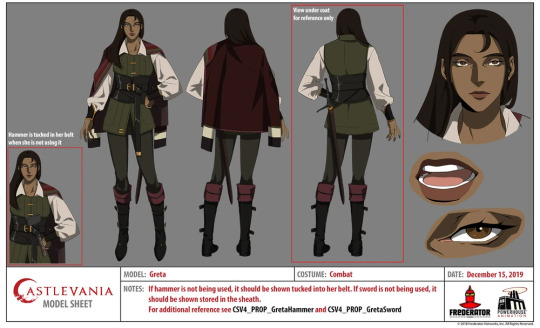
She's the village headwoman of Danesti a few miles away from Alucard's castle.
This is what her voice actress, Marsha Thompson looks like:
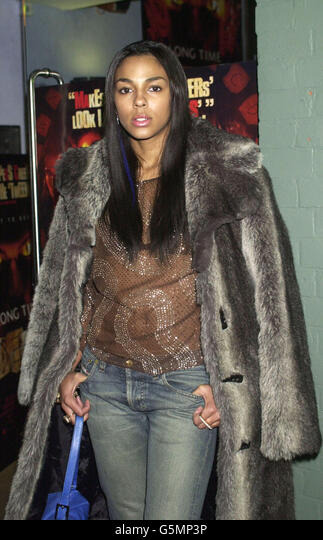
It's pretty obvious her character design took cues from the actress, who is Afro-British.
In show canon, however, her family escaped from the Roman city of Carthage, which today, is located in the African country Tunisia.
Alucard correctly speculated where her people are from while conversing with her, here (s4 e5):
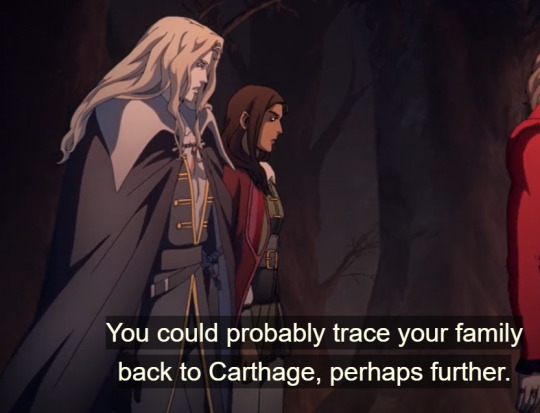
Greta then confirms that her people did escape the Romans, but she now fully embraces her "family" in her village who are "from all over" and the responsibility of taking care of them.
This same troll used the g-slur to insist that she is Romani.
She is not.
This troll used an early character design here, to make her case.:
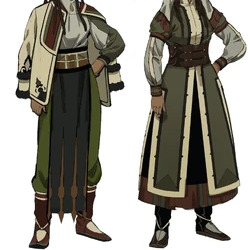
And though it does have similarities to Romani clothing... It also looks like it takes cues from Tunisian clothing and likely local and non-local European clothing of the era with "fantasy" elements sprinkled in, as well, which would match the fact of her village's people coming from all over:

There definitely should be more Romani rep in media as it is so often whitewashed, but Greta is not Romani.
FYI, these women actors actually *are* of Romani descent:
Fairuza Balk of The Craft, Oona Chaplin who played Robb Stark's wife in GOT (she's also Charlie Chaplin's granddaughter[!]), and Noomi Rapace from the Swedish movie, The Girl With The Dragon Tattoo says her father may have been of Romani descent, as well.
And because I can predict it, as people like to find ways of discounting blackness in every way...
Yes, there are plenty of non-Black indigenous POC in North Africa, including within Tunisia.
Another fun fact... Africa has more indigenous human genetic variation among its peoples than every other people on the planet has with everyone else on the planet[!].
All this to say non-white POC AND Black people are indigenous to Tunisia.
I feel I have to say that because there is a lot of anti-Black anthropological fetishization of North Africa. Egypt is a major example of that (see: Rami Malek, an indigenous Coptic Egyptian who self-identifies as African man of color and has likely had to clarify that *often* because people keep wanting to mislabel him as an Arab, but I digress...)
And sadly, there is a decidedly anti-black movement to totally disconnect certain North African countries' identities from a continental African one, and to largely see it as mainly a part of the MENA world (it is both kiddies, BOTH).
Here is an informative article (linked in the image) about that struggle:
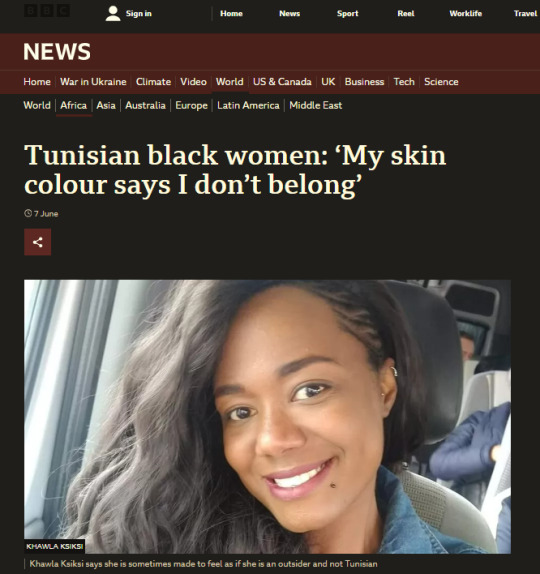
So, this got heavy...but between the post insisting that Greta is NOT Black and the one saying she's not bisexual because that same troll is purposefully and maliciously being obtuse about how words go together...
I figured clearing some things up and educating folks might be helpful.
BTW, the fact of those issues in the article makes her blackness all the more resonant as rep in pop culture.
And hey, poly folks have disagreements, just like the het folks do...
-Still bi.
I'm gonna end here with two images from the linked article of anti-racist Tunisian protesters (MENA and Black):
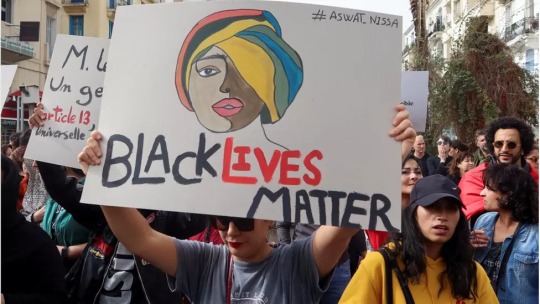
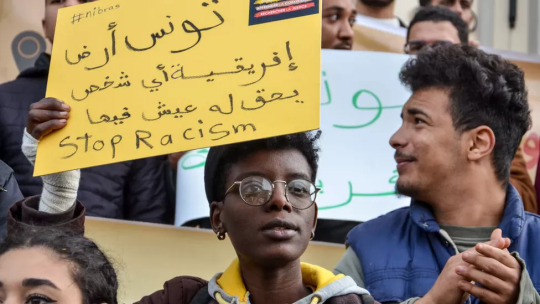
P.S. I also side-eye those keen to make her muscular... I mean yeah she wields a big-ass hammer and shortsword/dagger, but the tendency to masculinize black woman characters deserves a hardy eye-squint.
Especially, given that the show has *no problem* making muscular women look like that and they DIDN'T for Miss Greta.
See: Zamfir and the Berserk-style sword-carrying Vampire warrior, Striga. Both of whom had that flex going on.
#tumblr gonna tumblr#misogynoir#greta danesti#greta x alucard#castlevania#I hate when wrong-ass trolling info is spread in the tumblr fandom tags about black women characters#and sadly it happens A LOT purposefully#if you don't like black women just stick to the characters you like instead...you really gotta put in effort to actively HATE as a hobby#same ole same ole#meta#one kinda hate ALWAYS comes with another#which is why solidarity makes sense#troll is anti-black & biphobic#so this is becoming a thing?#doing my best to make sure the black girl character tags have GOOD info about the characters#first uhura and now greta#sunday wip procrastination blah#block that “gretasworld” troll#btw the producers say she's not a spin-off Grant Dynasty so...that's why he's not mentioned
93 notes
·
View notes
Text
Red Dress Day: Honouring Memories and Raising Awareness for Missing and Murdered Indigenous Women, Girls, and Two-Spirit People
May 6, 2024
Shaina Tranquilino

In Canada, Red Dress Day serves as a poignant reminder of the ongoing crisis surrounding missing and murdered Indigenous women, girls, and two-spirit people (MMIWG2S). This solemn occasion, marked by the hanging of red dresses in public spaces, symbolizes the lives lost and the urgent need for justice and systemic change. As we commemorate Red Dress Day, it's crucial to reflect on the profound impact of this crisis and renew our commitment to advocating for the rights and safety of Indigenous communities across the country.
The Significance of the Red Dress:
The red dress has become a powerful symbol in the movement to raise awareness about MMIWG2S. It represents the women, girls, and two-spirit individuals who have gone missing or been murdered, their spirits, and the bloodshed that continues to stain the fabric of Indigenous communities. Each red dress hung serves as a silent tribute, a visual reminder of lives cut short and families torn apart by violence and injustice.
Honouring the Memories:
Red Dress Day is a time for reflection and remembrance. It's an opportunity for communities to come together to honour the memories of those who are no longer with us. Through ceremonies, gatherings, and art installations, Indigenous and non-Indigenous people alike pay tribute to the lives lost and reaffirm their commitment to seeking justice and accountability. It's a solemn occasion but also a chance to celebrate the resilience and strength of Indigenous communities in the face of adversity.
Raising Awareness and Demanding Action:
Beyond remembrance, Red Dress Day serves as a call to action. It's a reminder that the crisis of missing and murdered Indigenous women, girls, and two-spirit people is not a thing of the past but a present-day reality. Indigenous women are disproportionately affected by violence and are more likely to experience homicide or disappearance compared to non-Indigenous women. This alarming statistic underscores the urgent need for systemic change to address the root causes of this crisis, including colonialism, systemic racism, poverty, and inadequate access to resources and support services.
Advocates and activists use Red Dress Day as an opportunity to raise awareness about MMIWG2S and to demand action from governments, law enforcement agencies, and society at large. They call for improved support services for victims and their families, culturally sensitive policing practices, and meaningful efforts to address the underlying factors that contribute to violence against Indigenous women and girls. By amplifying their voices and advocating for change, they strive to ensure that the lives lost are not forgotten and that future generations can live free from fear and harm.
Red Dress Day is a solemn yet empowering occasion that reminds us of the ongoing crisis of missing and murdered Indigenous women, girls, and two-spirit people in Canada. As we honour the memories of those who are no longer with us, we must also recommit ourselves to the fight for justice, equality, and respect for Indigenous rights. By standing in solidarity with Indigenous communities and demanding action from our leaders, we can work towards a future where every woman, girl, and two-spirit person is safe, valued, and able to live their lives free from violence and discrimination.
#red dress day#MMIWG2S#honouring memories#lost lives#stolen lives#Indigenous rights#justice for MMIWG2S#end violence#solidarity#awareness#demand action#equality#justice for Indigenous women#remembering our sisters#resilience#Indigenous strong#end violence now#support Indigenous communities
28 notes
·
View notes
Text
okay i have more (critical) barbie thoughts under the cut.
i really did enjoy it overall. it was fun, cheeky, surreal. i loved the experience of watching it in an energetic theater. i even cried a couple times. but i’m baffled at how powerful it was for so many people when it fell so flat for me. honestly, maybe what i’m feeling is just because i’m trans and it didn’t resonate as strongly with my experience of womanhood or masculinity.
i keep coming across people using gloria’s monologue to dismiss criticism by saying “anyone saying barbie isn’t feminist enough are doing the exact thing gloria pointed out! women have to be perfect but it’s just never good enough!” Y’ALL. having issues with a high-budget, corporate funded movie that has the same milquetoast girl-power messaging you’d find in teen mags from the early 2000s… is not the same as oppressing women under patriarchy. you can critique media and still resonate with aspects of it. good grief.
another response i’ve seen to critiques (specifically of gloria’s monologue) is that the movie’s messages are meant for barbie herself! not for the audience! it had to be super tame and generic because otherwise barbie wouldn’t have understood! all those speeches and ideas are aimed solely at barbie who is learning about all of this for the first time! it’s not for you if you already get it! what?????? that’s not how media works and you know it.
also, the idea that it’s meant to be palatable for a “wider audience” so it couldn’t have included intersectionality without losing people. translation: “wider audience” means white suburbia? white men? cishet people? where the most “representation” they can tolerate is a 3 second clip of a voiceless barbie in a wheelchair dancing? or a black president barbie who mostly says one liners and disappears? a wider audience being the same audience every blockbuster is catered towards?
i’m just spit balling here, but i don’t think it would have been impossible to introduce some unironic nuances like:
america’s latinx character experiencing sexism differently from stereotypical barbie?
maybe not using mount rushmore repeatedly to symbolize who’s in power?
avoiding comparing bringing patriarchy to barbieland to indigenous genocide?
a harsher perspective on mattel’s role in all this? where the outcome isn’t just will farrell’s character griping that he doesn’t even want to be in charge, he just wants to be tickled? (wtf was that lmao)
making a more obvious statement that patriarchy isn’t just a symptom of men stumbling across power and relishing it but that it’s rooted in violent white supremacy and capitalism? i’m positive there’s a way to address that without going full blown academic feminist theory mode.
having the black, fat, and disabled characters speak more than 5 collective minutes? (but at least they had screentime at all, right? ✨representation✨)
explicitly queer characters instead of “weird barbie” and allan being coded as the outsiders to an otherwise regimented cishet universe?
but all those ideas are irrelevant, right? because the movie was just SOOO self aware and layered in irony and if i was smart enough and hadn’t missed the point, i’d know the writers were in on it all.
#barbie spoilers#barbie#barbie criticism#h#okay one last vent#it’s wild to me that people are like ‘no one picks apart movies made by men like this! it’s because everyone hates women!’#creative work made by women is often more heavily scrutinized than work by men#so i think it's necessary to keep that idea of undue scrutiny in mind as we consume media#but at the same time it's not a reason to just avoid engaging with women's work critically#am i losing it?#i’m losing it#also specifically with movies like barbie#if they're going to very openly and specifically address patriarchy and misogyny to make a statement about them#would it not make sense that those themes would be at the front and center of criticism?
77 notes
·
View notes
Text
quick blurbs of some of the 10 plus jax teller x ofc fics i have saved; tell me which i should go with to fully flesh out.
Untitled (Jax Teller/OFC; Main female character is Latina, Her oldest brother is Latino, and her other brother is Black)
Our FMC, along with her two older brothers, move into Charming and open a few businesses. What the club doesn't know, is that these three newcomers are Zobelle's children...only they're his soliders. Zobelle had mixed children for their genetics and trained them each in the typical underground jacket of violence.
He uses them as a last resort to take over a place. Zobelle installs his children before moving into town. First few chapters cover moments in Season One involving the new three characters before getting into the arc of Season 2. AU. Deals with the complicated race issue in Charming, and the MC. Juice's secret may come out more earlier. This is the Zobelle plotline extended. Psychological, racial, familial bonds are all questioned and explored.
---
2. 2 Fast 2 Untitled (Jax Teller/OFC; Latina)
Our FMC (Sunny) is Luann and Big Otto's adopted child who grew up with our normal players. When Donna is murdered, Sunny comes back into Charming after two years away to help with her godchildren. Tara only remembers Sunny as the little quiet girl, not the confident women who seemed to have a history with Jax, much to Gemma's pleasure. AU. Complex love.
Blurb:
Tara waited for Jax to stand behind her as all of the club members who were family did to their Old Ladies. But her face dropped as he walked past her. She was even further shocked when she saw him stop to stand next to Sunny, both facing opposing directions, Sunny facing the funeral, and Jax facing away from everyone. Her stomach churned as she saw Jax place his hand on Sunny’s deeply curved hip. She watched the rest of the scene play out like a bad television show.
Jax leaned down and kissed Sunny’s temple, walking away without looking back.
Sunny looked at Opie, an apologetic look on her face.
Opie nodded in the direction Jax walked.
Gemma squeezed Sunny’s hand that she held.
Sunny leaned down and kissed Gemma’s head. She turned and walked towards Jax.
Jax, without looking behind him, held his hand out, knowing she would take it.
Sunny, like she always did, caught up to Jax, her hand resting in his.
Tara was fucking confused. She knew she had missed so much, she knew that everyone was keeping so many things from her. But she had no idea what the fuck just happened. She leaned over to look at Gemma, knowing she would have something to say.
Instead, Gemma just gave her a quick nod and sly smirk.
Tara didn’t like the feeling she got.
----
3. Guess what? Untitled as well. (Jax/OFC, Angel/OFC, Juice/OFC; Our three MFCs are Latina with an Indigenous background, Mexican with an Indigenous background, and Black with a down South, Texan background.) AU. This eventually will see the truce with SOA and the Mayans through the women.
Through the Grim Bastards, SAMCRO hires three women to jump Cherry and Ima; through the three women, the club is now connected to even deeper gun and drug ties causing the rift between Jax and Clay to only worsen. As some of our MCs partner up with members of SAMCRO, Gemma is pissed as she can't manipulate these three. Mixing representation, with culture and spirituality as both SOA and Mayans MC, this is meant to be more dramatic like the show(s).
----
4. Untitled Fore! (golf ref haha) (Jax/OFC, Thomas!LivesAU, Tommy/Tara)
An AU where Thomas never died. A little girl became a Cinderella story in Charming. But SOA ain't a fairytale baby. After Jax and Tara break up, Thomas and Tara go to school together, eventually falling in love. Jax and OFC are on and off. A different take of the big events of Season 1; Donna dying, creepy Kohn, sneaky Stahl, and the divide between Jax and Clay. With Tommy and Tara both facing off against Clay and Gemma, it's a race between them both to rope Jax and OFC to either side before the club gets deeper into violence.
----
5. Cinco de Untitled (Jax/OFC; OFC is Juice's sister. This is SOA from day one with my take of Juice's sister involved. David!Lives, Tara/David Hale) AU. Smutty.
Blurb:
Jo blinked. Before she knew it, she had her hand wrapped around Wendy’s throat.
Wendy clawed at Jo’s hand, surprised at her actions. Jo never was known to her to ever throw a punch. Her windpipe was narrowing with heavy pressure and speed. She gasped for air that couldn’t be reached.
-
David nodded. “I told you, it’s a long story. Let me get there,” he bumped Tara’s shoulder with his own.
Tara laughed, moving with the small push. She bumped his shoulder back playfully. She giggled as she saw a small blush come across David’s face. She felt a lick in her stomach; it had been a while since she made a man do that, and it made her feel good. “Sorry, sorry, go on,” she broke the moment between them.
----
6. Still not great at naming things (Jax/OFC) OFC is a newcomer into Charming with her young daughter. AU of SOA from the beginning.
Blurb:
Soleil turned to a shaking Jax. “Jax…”
“Sol, I gotta go. Hairy Dog? They’re–” Jax stopped quickly, shaking his head. Soleil may have suspicions, but she didn’t know exactly what the Sons did. Or that she was even around the mother charter. “I gotta take care of this…I can’t be, I can’t–” his nostrils flared. He shook his head.
Soleil blinked, looking into his eyes. She nodded slowly. “Okay. Okay,” she licked her lips. “Go do what you need to do. Gemma and I will hold off DFCS until you take care of it, but that means,” she reached up and grabbed his chin sharply, making him look at her. “That means you come back. Because you heard what the doctor said. He’s stable. As long as he stays that way, he has a chance. When you come back, I’ll tell you how Selena almost didn’t have a chance when she was born either,” she breathed, watching Jax’s electric blue eyes widen in shock. “And she’s here. You held her. Just like you’re going to hold Abel. Okay?” She squeezed his chin. “You fucking come back,” she hissed at him, tears in her eyes.
----
7. 7th Untitled Hell (Opie/OFC eventual Jax/OFC)
FC dates Opie after Donna dies. Jax is attracted to her, but keeps his distance as she is Tara's one and only friend. When Opie dies, our FC and Jax both spiral down into each other's arms. Sisterhood of the traveling angst baybay.
----
8. What's four plus four? Still untitled. (Jax/OFC) Romance/Humor
Jacob Hale's very very young new wife visits Tristan in the hospital after the events in Funtown, bumping into Gemma and Jax, further complicating the already tense political and guardian relationship between the town and SAMCRO.
----
9. 9 circles of untitled hell (Jax/OFC, Happy's baby sister AU)
Happy's baby sister, who is the opposite of him, comes down to Charming for a quick trial run. Can she be the woman to settle Jax down and be the Old Lady he needs to change the club the way he wants now with Happy in his pocket? (I can probably do this as a one shot or a two parter!)
---
10. Untitled (Jax/OFC, Juice's baby sister AU.)
Juice's sister Julissa moves to Charming after tragic events; only a few months behind Wendy in pregnancy. As Julissa steps up to be Abel's mother as Jax also is the father that stepped up to Julissa's daughter, the club and Tara think they're involved, when in fact they are not. Butttt obviously that doesn't stay the same for too long. Meanwhile the normal bullshit is happening with the club.
---
11. Untitled (Jax/OFC)
The little girl that Gemma had sent away long ago comes back with a tragic story. Feeling guilty, Gemma takes her under her wing. Unbeknownst to Gemma, that once little girl knew exactly the Queen's role in her forceful exit and has a plan to take the Queen down. While its Jax vs Clay, Gemma will have her own battle to deal with FC.
----
12. Untitled (Jax/OFC)
Miguel Galindo's baby sister runs for Mayor of Charming. While appealing to keep Charming, Charming, the town is weary over her cartel connections. (I can probably make this a one shot actually!)
---
Let me know which one you guys want me to do first! I eventually want to do some of the ones on this list, but let me know which I should do first!
#sons of anarchy fanfiction#jax teller fanfiction#jax teller x reader#mayans mc fanfiction#juice ortiz fanfiction#juice ortiz x reader#opie winston x reader#opie winston fanfiction#angel reyes fanfiction#angel reyes x reader
13 notes
·
View notes
Text
Not so subtle reminder to my followers, especially those in Canada ect, if you don't know about the mass cultural genocide of indigenous people within Canada & The US.
On September 30th, it's national Truth and Reconciliation day in Canada. Which is a honestly our government's bullshit way of getting away with not really acknowledging or doing anything to actually reconcile with their murder of children.
As a mixed Native, I'm honestly sick of seeing the lack of care I see on social media and in society for indigenous people. I'm over it. I'm tired. My heart bleeds and aches when I think about how many children never made it home and how many Missing and Murdered indigenous women, girls and 2spirit people there are.
I want allies to step it the fuck up. Where is the same outrage, where is the fire, where is the passion you have, especially looking at you white allies, for everyone else?
Land Back. Real truth and reconciliation. Listen to indigenous people.
Here are some starting points.
86 notes
·
View notes
Text
(Part 1) Underrated Recommendations for Film & TV
1. Wolfwalkers (Film, 2020)
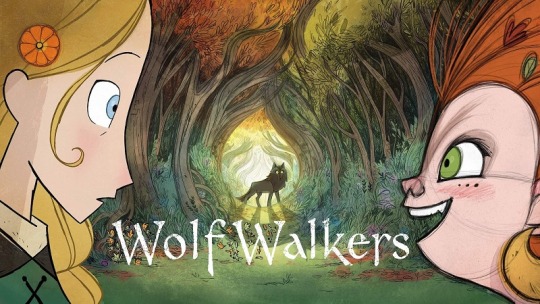
Wolfwalkers follows the story of Robyn Goodfellowe, a young apprentice hunter who arrives in Ireland with her father during a time of superstition and magic to wipe out the last wolf pack. While exploring the forbidden lands outside the city walls, Robyn befriends a free-spirited girl, Mebh, a member of a mysterious tribe rumored to have the ability to turn into wolves by night. As they search for Mebh's missing mother, Robyn uncovers a secret that draws her further into the enchanted world of the Wolfwalkers and risks turning into the very thing her father is tasked to destroy.
2. Reservation Dogs (TV, 2021)
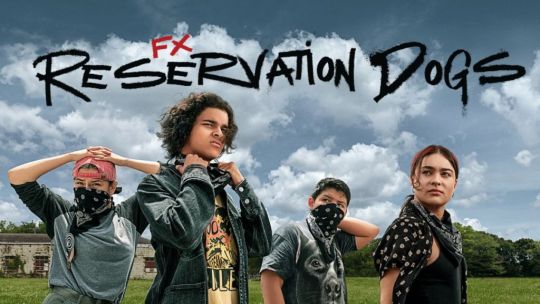
Reservation Dogs follows the exploits of four Indigenous teenagers in rural Oklahoma who steal, rob, and save in order to get to the exotic, mysterious, and faraway land of California. To succeed, they will have to save enough money, outmaneuver the methheads at the junkyard on the edge of town, and survive a turf war against a much tougher rival gang.
3. The Breadwinner (Film, 2017)
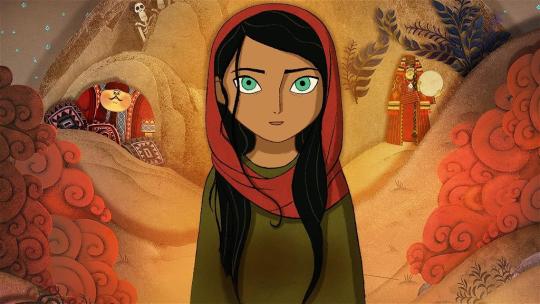
Parvana is an 11-year-old girl who lives under Taliban rule in Afghanistan in 2001. After the wrongful arrest of her father, Parvana cuts off her hair and dresses like a boy to support her family. Working alongside a friend, she soon discovers a new world of freedom and danger. Drawing strength from the fantastical stories she invents, Parvana embarks on an epic quest to find her father and reunite her family.
4. Carol & the End of the World (TV, 2023)

With a mysterious planet hurtling towards Earth, extinction is imminent for the people of the world. While most feel liberated to pursue their wildest dreams, one quiet and awkward woman, Carol, stands alone—lost among the hedonistic masses.
5. Infinity Train (TV, 2019)

The series is set on a gigantic, mysterious and seemingly endless train traveling through a barren landscape, whose cars contain a variety of bizarre, fantastical, and impossible environments. Passengers on the train proceed from car to car by completing challenges which help them resolve their psychological trauma and emotional issues. Every season of Infinity Train (referred to as a "Book", each with its own separate subtitle) follows its own storyline and set of characters, although some characters appear across multiple seasons.
6. Moral Orel (TV, 2005)
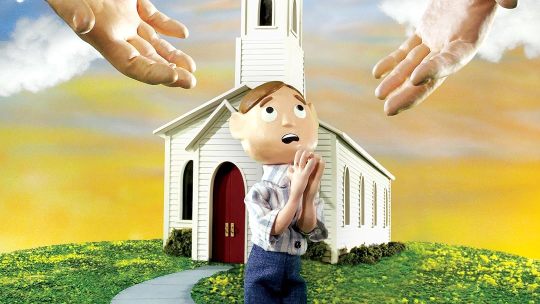
The series follows the titular Orel Puppington, a young, happy-go-lucky and naïve Protestant who showcases his commitment to God, while dealing with the cynicism of his abusive and alcoholic father, his lethargic mother, and the devoutly Protestant town of Moralton in which he resides.
7. Bee and PuppyCat (TV, 2013)
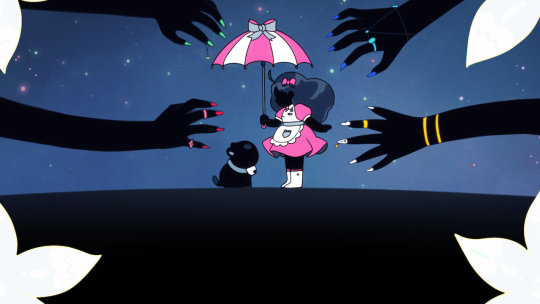
The series revolves around Bee, an unemployed woman in her early twenties, who encounters a mysterious creature named PuppyCat. She adopts this apparent cat-dog hybrid, and together, they go on a series of temporary jobs to pay off her monthly rent. These bizarre jobs take the duo across strange worlds out in space.
8. Tuca & Bertie (TV, 2019)

This animated comedy series explores the friendship between two 30-year-old bird women who live in the same apartment building. The buddy comedy features cocky, carefree toucan Tuca and anxious, daydreaming songbird Bertie as they live their lives in the metropolis of Bird Town.
9. Wander Over Yonder (TV, 2013)
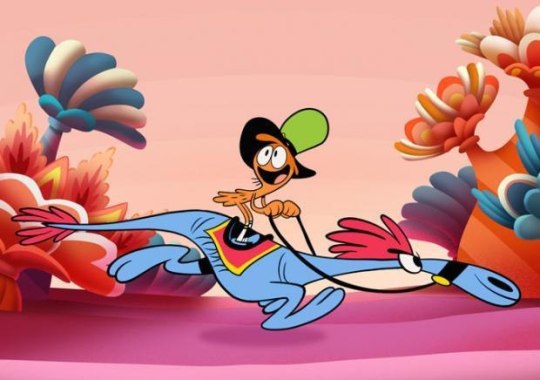
The series follows Wander, a nomadic, helpful, and overly-optimistic intergalactic traveler and his best friend and steed, Sylvia the Zbornak, as they travel from planet to planet helping people to have fun, play, and live free, despite the continuing encroachment of Lord Hater, one of the most powerful villains in the galaxy, and his army of Watchdogs.
10. The Midnight Gospel (TV, 2020)
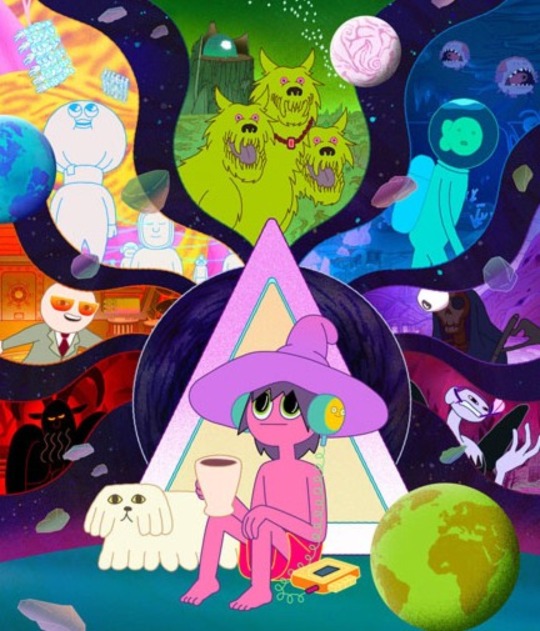
The Midnight Gospel revolves around a spacecaster named Clancy Gilroy, who lives on the Chromatic Ribbon, a membranous, tape-like planet situated in the middle of a colorful void where simulation farmers use powerful bio-organic computers to simulate a variety of universes from which they harvest natural resources and new technology. Each episode revolves around Clancy's travels through planets within the simulator, with the beings inhabiting these worlds as the guests he interviews for his spacecast. These interviews are based on actual interviews, with real audio sampled from Trussell's podcast, The Duncan Trussell Family Hour.
#tv shows#tv series#tv#film#films#movies#movie review#movie#movie stills#review#reviews#tv review#film review#film recommendations#film reccs#movie recommendation#movie rec list#movie recc#tv recommendations#tv reccs#tv show#recommendations#rec list#underated#underated movies#wolfwalkers#reservation dogs#carol and the end of the world#infinity train#animation
10 notes
·
View notes
Text
in lieu of a reading week
11pm, tuesday, feb 20, 2024
hello beloveds. just wrote two increasingly passionate paragraphs about what social media and my use of it over the years has done to benefit my life, and got so genuinely moved that i had to come talk to you about it.
reading really wild mix of reading material of late. surprisingly high amount of YA, because people keep recommending me things and i keep going 'sure, let's try it!' so i'll use that as an organizing principle and save discussing some of the others for a future post. in order of completion:
firekeeper's daughter, angeline boulley, read by isabella lablanc. finished in a rush, very engaged in the last three-four hours. i was never prepared for the next thing this plot threw at me, though in retrospect saw how it all made sense. i didn't know a thing about it going in, which i think actually enriched the experience a lot, but for a novel set in michigan's UP and sugar island, it resonated with a lot of things i associate with ontario after living here for five+ years. the hockey, the ojibwe /anishinaabe names and cultural connections, the murdered and missing indigenous women. but it also mixes in elements reminiscent of, like, braiding sweetgrass (and tangentially mexican gothic) and various fan fiction tropes i recognized in their shape if not their execution. highly recommend the audiobook-- they cast the audiobook's narrator very carefully, and she does a superb job juggling the mix of scientific jargon, teen narrator unreliable/dramatic narrator (loving), and Anishinaabemowin.
castle in the clouds, kerstin gier, translated by romy fursland. maybe 33% through. it's giving grand budapest hotel and somehow also the princess diaries? it's also reminding me somehow of, like, the kind of novel i wanted to write as a second or third grader, which means eva ibbotson, and a particular flavor of plucky, intelligent heroine. i was hooked by the first page+ but have yet to see a ton more of the same high action and suspense, and have let this one slip a little further onto the back burner. it's cute escapism at the moment, though that may change.
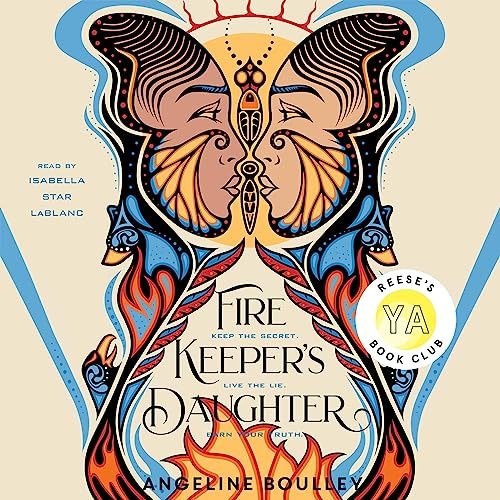

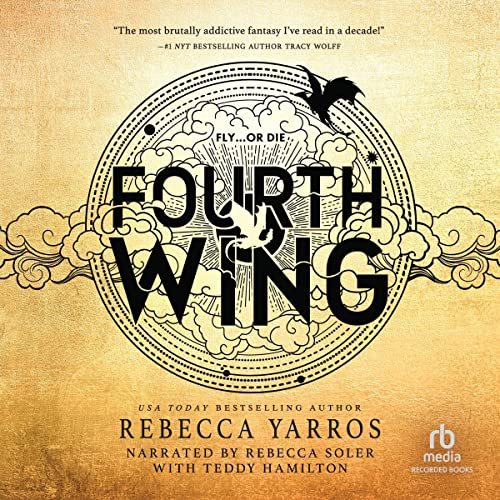

fourth wing, by rebecca yarros, read by rebecca soler (and apparently also teddy hamilton, although i haven't gotten to him yet?) about 25% through. trying desperately to give us a gritty, hardcore, new and dangerous and fun take on dragons and their human riders, while also trying to be idk divergent? the hunger games? there's a love triangle, the protagonist has naturally ombre hair, the premise of the novel is brutal training where young adults are all dying in improbable droves due to how cutthroat and brutal it is. a testament to the narrator that i am, despite myself, having a great time. there are a few too many supporting characters who want our main girl straight up dead for me to really find the threats believable, but i'm intrigued by the prospect of alternate versions of this world's history than what she has learned and a potential for discovering how their kingdom has? manipulated them? could be asking too much.
fairest, gail carson levine. finished in a long saturday morning spent reading in bed. i was such an intense and dedicated fan of the original ella enchanted novel that i couldn't read most of levine's other books (exceptions for her short stories made grudgingly) because they weren't sequels and weren't the same and wouldn't be as good. in fairness, reading this now as a much-older-than-the-intended audience, perhaps i was too harsh-- but i think little-me was right to be a little suspicious. it's a snow white retelling, and again i think largely successful in building a more detailed plot in which the elements of the retold fairy tale are embedded, but where the focus in ella was on language and obedience and free will, here we're trying to articulate things about beauty and body image, and it's harder to say that it really succeeds? i like that we gave the Wicked Queen more nuance, positive and negative qualities, moments of sympathy, a name and a precarious political position. i was not nearly as charmed by the romance (fine, fine, it's not ella and char but it couldn't be, it's fine). i still love the use of unfamiliar / fairy-tale languages and how levine puts them on the page in such fun spellings. probably aimed at the youngest audience, of the four titles here, but treats its reader as almost more intelligent than fourth wing, possibly? YA from ~twenty years ago was a different world.
listening graded like twenty quizzes today with just a mess of random panic at the disco bumping in my headphones. it's a hell of a feeling, etc. i'm halfway through this particular round of grading, and they're doing so well, so it's mainly a quick check to make sure they got the basics right and i can jam while doing so.
watching spent a very pleasant ~2 hours yesterday watching as much as we could of the film amadeus with @hematiterings, @pep-squad-lizzie, and @dimir-charmer. love a film that isn't afraid to lean into all its sensory indulgences, and to be a little heavy-handed with its symbolism (the chocolate is about repression!) and to, just generally, spend money on costumes, locations, hiring lots of extras, and so many wigs. there's a live event performance of this film with orchestra + choir being advertised all over our subway right now, so it does very much feel like we're being followed by this guy:
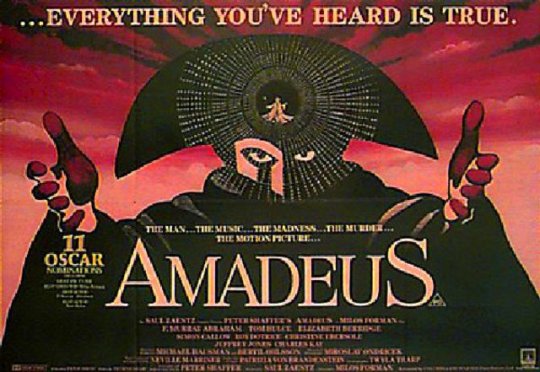
...but what's sticking in my head right now is the costumes.
playing 41+ hours into hollow knight. i have opened half of my stag stations! i have the dream nail, surprisingly early i think! i have saved bretta! i have somehow missed the mantis lords, i think, but have made it to the city, the resting grounds, and have now been throwing myself fruitlessly against the crystal guardian and a soul warrior in alternation. i am...not good at combat. current plan is to grind to get quick focus, and i'm close! also, @spoonierbard stepped in and gave me a much needed morale boost by winning me the final mask shard necessary to get increased lives, which has helped tremendously, and the grubs rewarded me with the grub song charm which has helped tremendously.

making many potential projects, none executed (or even really attempted). soon, hopefully. fallow section for now. does music count? music counts, right? i joined a second choir! enticed by the chance to perform mozart's requiem in full with an orchestra, and finally fulfill the broken promise of 2020. that's my hobby right now. oh i also just cleaned out a ton of storage in my phone + icloud, which felt generative in its own way. besides backing things up better than i have in a while.
working on submitted the travel money application i've been thinking and dithering about since...this time last year? no real expectation of getting it, but it did actually help me consider some next steps in the diss, so that's nice.
now prepping to take my class on two fun on-campus field trips next week, one to the manuscript library and one to the medieval collection in our little hidden art museum! i need to write some notes up for the TAs and docents to use, and finish organizing my list of desired manuscripts, like, yesterday. midterm grades posted today, a little late but hopefully not too bad, still well before the drop date. the aforementioned quizzes (i have like 28 more to grade, but they're reasonably painless). plus i was going to work on my fucking dissertation this week, and prep to teach the next few lectures in advance so i'm not scrambling monday nights, plus send a bunch of emails, design a CFP poster, put in some RAship hours so i can speak intelligently in my meeting tomorrow, and....prep for the guest lecture i'm giving on the 28th! it's a reskin of the conference paper i gave this summer, freshly edited, but i need to expand the intro bits to include a useful overview, since these students aren't a conference of celticists.
weirdly at peace with how my work-life balance is balancing right now, though. it's the extra sleep and the increased sunshine, and the little cat who is being so so whiny right now. i must conclude these lines and feed Herself.
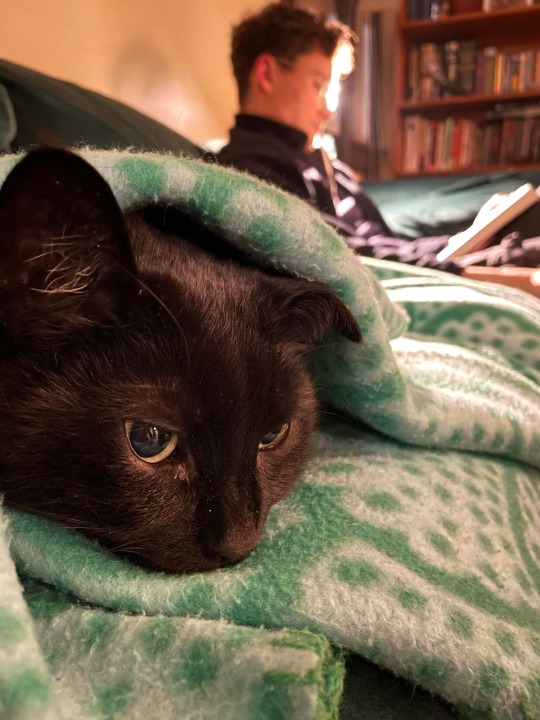
#in lieu of a commonplace book#ilcb#going to cave and admit the truth and tag this:#monthly roundup#click for gratuitous cat pic featuring: housemate blurred for anonymity#Spotify
17 notes
·
View notes
Text



I was able to view an exhibit at the George Washington Carver Museum’s We Ride For Her Red Dress Exhibit in Austin, Texas. Right in the entrance of the museum one can see over forty red dresses of all sizes hanging from the ceiling, each representing an Indigenous woman or girl who has gone missing or has been murdered. I was able to feel the sense of emptiness each dress created, as if it was a big closet full of dresses waiting to be put on by a woman or girl who can’t anymore, as if there was a hole in the world where a woman should be. Also at the entrance is a table with red ribbons and sharpies for visitors to write down the names of loved ones who are missing or murdered Indigenous people and pins to pin these ribbons to the blanket dress at the front of the exhibit. Inside the exhibit there are a multitude of mediums honoring the Indigenous women and two-spirit people who have gone missing, been murdered, or raped. Immediately one sees the Loved Beyond Words Dress. This Dress is a white and red Jingle dress, in red writing one can see the names and descriptions of MMIW, along with kind words. There were seventeen women in total honored on this dress, only one, Esther Smith, has been found after being missing for 14 years. All of the words on the Loved Beyond Words Dress were given by the families of these victims.
Photo Sources:
Adams, personal photos, March 23, 2024.
11 notes
·
View notes
Note
Mun, give me your shot on Usagi Headcannons :crying & fire emoji: the world needs it
Of course! Here's what I got so far in terms of backstory and tidbits about him too:
Usagi's parents are Robert Alohaoe and Donna Therese Alohaoe (née Nakashima). Both are Japanese-Hawaiian descent and Usagi is their only child. Usagi had a twin sister that didn't make it to term but neither of his parents told Usagi her name or that she existed, not wanting their son to feel guilty or sad about the matter in any way.
Robert was a construction worker who was also the local construction union's president. Donna works as a receptionist for a retail tax office in Downtown Honolulu. After Robert's death, Donna quit her job due to grief and now stays at home. She's able to manage the payout for Robert's death so she and Usagi could live comfortably and more and is rather frugal too.
Growing up, the Alohaoes were a close, loving family. They were actually involved in a local church in Honolulu and Usagi's early years were him being involved in things like the children's choir and plays done in celebration of Christmas and Easter. The church itself was a nondenominational Christian church that the Alohaoes met through and got married in.
Both parents wanted Usagi to have some exposure to the arts but lacked the resources to give him professional classes or have him try out auditions for agencies, so Usagi's time in the performing arts involved him taking free community classes or attending volunteer-run events. It's there that he learned how to dance, sing, and act.
Usagi was a rather popular kid with many friends from church, despite his father worrying that being a theater/dance kid would mean kids were going to bully him. His rise to fame among the church kids was when he showed that he could do the splits during a free ballet class. He was also, at the time, strong enough to lift the girls trying to pretend to be ballerinas.
Robert's death threw more than just a wrench into things. Despite the church doing what they can to help and comfort, both Donna and Usagi lost their faith and stopped attending services like before. Usagi briefly stopped doing theater stuff and stopped seeing his friends at church. He became a loner in school that people thought was weird. He often brushes off his father's death as a means of coping with it. But, secretly, he misses his dad a lot.
Usagi himself isn't religious anymore as he started getting involved in scientific research and not agreeing with sentiments that various religions have towards marginalized groups (women, lgbtqia+, indigenous, etc.). But, when he misses his dad or really needs divine intervention, he will say a little prayer and hope it gets answered.
To satisfy his itch for performing later in life, he turned to learning Kpop choreography and making Kpop content. He has a secret social media account where he dresses up with his face and body covered and films himself doing dance covers. He would also attend Random Kpop Dance Plays anonymous as well to talk to other stans. Everyone knows him as his dance persona but no one really knew who he is under the all-black fits and surgical masks he wears.
He's massive in the forums related to BTS. Online, ARMYs knew him as an i-lovely with wacky theories about the BTS universe and his love for Suga. His biaswrecker is Jimin and he eventually bonds with Charming Man over BTS as the two start to become more friendly with each other. Usagi also runs an anonymous stan twitter account to help him keep up with Kpop news and is really involved in voting during awards season.
Since his father's death, Donna has been way more overprotective than before. Usagi himself was a sheltered kid and sometimes feels suffocated by her actions. He does understand that he is arguably the only physical reminder of Robert and her intentions are well-meaning, but it has caused him to rebel secretly. It's part of why he accepted work from Meryl Mei and experimented with drugs. He does it behind her back because he doesn't want to disappoint his mom in the end.
Usagi wishes to be a researcher of sorts after high school, but he's not sure what field to go into. He's considered being an ornithologist because he loves birds but also a pharmaceutical scientist, hydrologists, research physiologist, and, when he was younger, he thought about being a marine biologist. His passion in being a researcher led him to learn a lot of stuff online and that's why he has so much information.
His experimentation with drugs came from his initial desire to be a pharmaceutical scientist and curiosity on how chemicals can affect a body's function. He also wanted to see which drugs would enhance his academic performance the most, so he extensively researches on the drugs and how to safely use them before actually trying it on himself. It's also where he gets his extensive medical knowledge.
Donna used to be someone who wanted to make sure Usagi has a home cook meal and the family used to bond over cooking. However, since Robert's passing, Donna stopped cooking out of grief and Usagi can't bring himself to cook for similar reasons. He's mostly eaten takeout fast-food or quick meals like instant ramen since then. Donna is trying to get back into cooking meals again for Usagi's health but it's still a struggle.
Usagi doesn't know much about his dad's past but is interested in Robert's dadlore; Donna herself only knew so much. The bits and pieces of the lore Usagi knows is that Robert used to be close friends in high school with some guy name Dean. The two separated after a terrible fight but reconnected months before Robert passed away. Usagi knows it was this friend who helped his family receive the insurance payout but he doesn't know Dean's full name.
Usagi only knew Dean by the nickname Robert supposedly gave to him and the two had nicknames for each other; Robert was called "Fripp" and Dean was called "Belew". However, Usagi misheard these names and thought the nicknames were Pink and Blue.
Usagi vowed to be like Dean, someone who goes out of their way for others, and hopes to find his own Pink that he could help the way Dean did. What a coincidence that that Pink ended up being Dean's own child: Dragona.
That's all so far. I hope you enjoy it. :3

#the jojolands#jjba#jojos bizarre adventure#jojo part 9#jjba part 9#jojolands#jjba jojolands#usagi alohaoe#jojo headcanons#jojolands headcanons#usagi's backstory is sort of referenced in that barbara ann backstory i wrote a little ago#the whole fripp and belew thing#also usagi is sort of inspired by a mutual of mine who is a huge usagi fan
9 notes
·
View notes
Note
I went down a rabbit hole on penis subincision, which lead to an edu article on sexual behavior in indigenous Hawaiian populations. (By Milton Diamond if you feel an urge to google). The article talked about how it was normal and even encouraged in a lot of these cultures for young people to engage in homosexual acts for the purpose exploring each other and simply having fun. This, in turn, reminded me of an assertion that Mark Thompson made in his book, Gay Spirit: Myth and Meaning...
--
....I’m not sure if you’ve read Thompson’s work but you posted passages from his book a while back. He compares the rejection a fixed gender identity and the phenomenon of "changing" to the archetypal definition of being a shaman, which is kind of fine. But then he goes on to claim that Diné (Navajo) people had a cross-dressing shamanic priesthood of gay people (the nadle) until white colonialism destroyed the tradition. Which, frankly, was a claim that I initially dismissed as...
…a gay white dude making things up until this whole subincision thing made me go look into it more closely. There are in fact many detailed articles on this. (They’re called Nádleehi, not nadle in these papers). So what I want to ask is if anyone knows exactly how common it was for LGBT+ to be accepted in non-colonial populations. Because I was under the impression that the consistent natural reaction to queerness in almost every human culture is to eradicate it.
Nonnie... WHUT?
YES, oh my god, a ton of cultures were okay with some form of something we would today see as queer.
YES, colonialism routinely wiped this out or at least tried to, and many of the places doing the colonizing also stamped out their own ancient traditions.
I don't recall that particular book or quoting it, but I post a lot.
It's not as clear-cut as total acceptance or acceptance of all forms of queerness. A common format is some kind of third gender role for nonconforming or trans or intersex people, often a combination of what we'd see today in the West as femme gay men and heterosexual trans women. Sometimes, this third gender had a specific social role, like shaman or entertainer. The modern split between gender identity and sexual orientation is not really how people saw it in a lot of past cultures (or, hell, in plenty of modern ones outside of the mainstream Western world).
When I was 14, I was fucking obsessed with this academic book of compiled journal articles called Third Sex, Third Gender: Beyond Sexual Dimorphism in Culture and History.
In terms of binary m/m interactions... uh... Ancient Greece is right there. Did you... miss that?
Historically, Japan was all about it being manly to fuck dudes because they didn't have girl cooties until the Meiji Restoration. Similarly to Ancient Greece, it was unmanly to take it up the ass as a grown man, but that's different from m/m sex in general being a problem. As with many societies outside of the mainstream West post... like... mid 19thC, m/m sex was seen as something you did, not something you were.
Medieval Europe would have kicked your ass for "sodomy", including oral with your spouse, which also falls under that term in that period, but they still wouldn't have thought a man was "gay" for fucking men. They'd have thought he was falling prey to a common sin that any man could potentially be tempted into. Sexual orientation is pretty much not a thing until after we get psychology as a science.
China got more homophobic over the dynasties. There was a time that the emperor's boyfriends were in the fucking history books along with his baby mamas. That's where we get the term "cut sleeve" from.
We don't tend to know what f/f stuff was going on in most times and places because most of the written record is men writing about their dicks.
Modern Thailand has all kinds of interesting things going on, and that whole region of SE Asia has had at points, though the more colonialism, the more local shit got suppressed. I can't speak to the total accuracy, but here's a wikipedia article on gender identities in Thailand.
Tibetan monasteries had abbots openly promoting their boyfriends. As long as you were doing it between the thighs and not touching icky girls, it was fine.
American Indian cultures are well known to have had fucktons of priesthoods/shamans of that type. It wasn't every group. Some were more prone to punishing gender nonconformity. AFAIK, a specific variant role for AMABs is more common than just letting people do whatever. In some, you could become a shaman, but they also tended to scapegoat the shamans in times of crisis. I'm no expert. I'd look up what modern two-spirit people have to say about their cultural traditions along with journal articles. The historical record is fragmentary and full of missionaries' unhelpful opinions.
Humans do often punish difference, but tons of cultures didn't see m/m sex or some specific form of third gender as anomalous. A ton probably didn't care about f/f sex, though it's harder to tell.
Gender conformity is often enforced... but why on earth would you assume most cultures only have 2 and that they map exactly onto our modern ideas of gender?
Seriously, nonnie, where have you been?
113 notes
·
View notes
Text
In Honour of Invasion Day <3 (/sarc)
I would like to be proud of my country. I want to celebrate the culture of mateship, siding with the underdog, telling the pollies to piss off and multicultural diversity... but how can I??
How can I be proud of my country when the day we celebrate the country is the very day that this nation got stolen from the 'traditional owners'. There's already a problem with that term, see, a lot of Aboriginal people (First Nation Aussies and Islanders) see it as they belong to the land, not vice versa. I would like to appreciate Kevin Rudd's apology speech back in 2008, but not much changed, so where's the apology in that??
The people who's land I am currently writing this on deserve better than being seen as "lesser". What people don't realize is that the racism in this country is far from gone. Did you know that the stolen generation legislation didn't stop being a thing until 1969? Sounds a long time ago, right? That was only 55 years ago. My mother is older than that. Let that sink in. There are 55 year old men and women out there who were stolen from their families and given to white people for some wankery of an excuse "so they can have a better life" more like so they can be "civilized" and assimilated to our culture which we deem correct and anyone who stands in the face gets murdered, thrown in jail or worse.
I would love to celebrate, crack open a tinny, play some cricket and sing waltzing fucking matilda but that's not right. I have no rights to celebrate when fellow Australians have little rights in general and are being put in jail left and right, beaten to a pulp and left to die in prisons. And of course their deaths get covered up. The police brutality in Australia is horrific because it's insidious (I'm about to write another post about this with statistics, so stay tuned). A lot of cops around here will let you off with a warning, chilled out... but that's my experience. As a white girl who can cry tears at her "mistakes". I remember once I talked myself out of a $200 on the spot fine for sneaking onto a train, said I lost my ticket and fake cried over it (shitty move, right? But to be fair, I couldn't afford the train ticket, let alone a fine). The officers were nice, gave me a warning. But how nice would they have been if I weren't white? I'd probably have been taken in to the station even if I genuinely had been crying, bought a ticket, and lost it.
There is so much fucking racism in this country. I remember being 10, disgusted as the class threw the new, Aboriginal kid under the bus for a missing toy in the class room. He didn't steal it. We found it months later. But the hell he got as the students and teachers blamed him for it? He moved schools (Darren, if you're reading this, I'm so fucking sorry for not doing more). This system is against them. And my country, my people, have the nerve to celebrate this culture on the day that marked genocide of people who were perfectly happy just living??
Sometimes I hate being white. It's an unfair advantage and I don't want anything to do with those colonizing aka land stealing genocidal bastards, but what the fuck is the point in having this privilege if I don't use it? If Indigenous people aren't getting heard then I'll stand with them, maybe this racist system will listen to a white girl.
(Final note, you're not punk if you don't fight the system, you're a poser, if you don't stand up for people who are dying you're an asshole, if you're part of a minority and let other minorities get squashes what the fuck is wrong with you, and last but not least, if you don't have an opinion on things like this, you might want to check your privilege.)
#rock rambles#delete later#invasion day#australia day#survival day#aboriginal people#indigenous people#stand for something#boost this#tw stolen generation#tw racism#we need to talk about this#we need to do better#Spotify
8 notes
·
View notes
Text
Anne With An E Rant❤️

My fav AWAE Season Is Season 3
Moira Walley-Beckett, creator of the show, weaves a tapestry of both the nostalgic and contemporary. The result is a masterpiece, with the idyllic and charming small town life of Avonlea a perfect contrast for the weighty issues the show tackles, issues that are particularly relevant today. The young but talented cast, led by Amybeth McNulty as Anne, Dalila Bela as her best friend Diana Barry, and Lucas Jade Zumann as Gilbert Blythe, bring the story of Anne of Green Gables to life.

The major theme of the show is its message of acceptance, beginning with titular character Anne Shirley’s struggle to be seen as something other than a ragged orphan who is up to no good.

When Matthew and Marilla Cuthbert (played by R.H. Thomson and Geraldine James respectively) take Anne into their home, they are unprepared for what’s coming. Her big ideas, matched in size only by her big heart, take the little town of Avonlea by storm at first. But the Cuthberts, along with the rest of the town, soon grow to appreciate Anne’s imagination, creativity, and kindness.

Not stopping there, Walley-Beckett introduces Queer characters, Aunt Josephine Barry, and Season 2 newcomer Cole (I fucking love him sm), a classmate of Anne’s. When Cole is shunned by his classmates and family for who he is, he contemplates suicide. It is only Anne’s intervention that saves him from a terrible fate. He eventually finds his place living with Aunt Josephine in Charlottetown, a more progressive town than Avonlea.

Walley-Beckett goes on to bring racial prejudice into the mix as well, with the introduction of Bash, a funny and lovable man who hails from Trinidad, and befriends Gilbert Blythe, Anne’s love interest, while they work aboard a steamer together. Bash goes on to become Gilbert’s business partner, and moves to his farm. It is Gilbert, Anne, and the Cuthberts who make him feel welcome in Avonlea, despite the initial rejection he faces by the rest of the town.

The fight for women’s equality comes into play as well, in the form of Miss Stacy (MY QUEEN) , the new schoolteacher, whom Anne calls a ‘kindred spirit’. An independent woman with radical ideas, Miss Stacy scandalizes Avonlea by donning trousers and refusing to wear a corset.

Season three is as funny and charming as it is heartbreaking. Taking place right when Anne turns sixteen and is busy preparing for the Queen’s College entrance exams, the season deals with acceptance once more: of our fellow man, of identity, and of growing up. Anne’s desire to find her birth parents speaks to all of us who have wondered where we come from. Marilla’s fear that Anne will leave her if she finds out about her blood relatives rings painfully true. It is here that Walley-Beckett teaches us that family is family, by blood or otherwise.

The racial prejudice theme is prevalent once more in Season Three. Bash, his wife Mary, and their child Delphine try to find their place in Avonlea, who is quick to spurn them based on the color of their skin. A new storyline featuring a Native American tribe, the Mi’kmaq, living in the area, sheds even more light on racial issues. The townspeople view them with disdain and fear. Predictably, Anne does not follow their example, and befriends Ka’kwet, a young indigenous girl. (I love their dynamic sm 💕)

With the Mi’kmaq storyline, Walley-Beckett does not gloss over the more unsavory parts of history, but instead brings things out into the open with Ka’kwet’s enrollment in a new school set up by the government for Native American children. What follows is a glimpse into the shocking events that occurred in that era, with the violent kidnapping of these young children, and their forced assimilation. The school turns out to be nothing short of a prison, where Ka’kwet’s beautiful braids are chopped off, and her Mi’kmaq heritage ripped away from her and her fellow classmates, starting with their being rechristened with English names, and forbidden to speak their language. Ka’kwet eventually escapes, but is taken back by force. Her desperate parents are threatened and shot at when they try to get her back.

Anne and her classmates stir up controversy in the town when they fight for freedom of the press after Anne writes a strongly worded editorial about equality. When Josie rejects Billy’s sexual advances, he spreads false rumours about her to ruin her reputation. When nobody looks at him as being in the wrong, Anne is indignant enough to write an editorial about the events that occurred. She comments on the double standards that seem to exist when it comes to gender, and the importance of spoken consent. The town board is infuriated, and retaliates by giving the paper a pre-approved list of appropriate topics to write about. They stipulate that the newspaper will be shut down unless they follow these guidelines, and fire the instigator of the controversy, Anne, from the paper. I'm proud that Anne did this.

Anne brings her classmates together to protest, and in a moving scene, they stand together, mouths gagged by handkerchiefs, and silently hold up a hand painted sign emblazoned with their message: Freedom of speech is a human right.

With this storyline, Walley-Beckett succeeds in addressing many of the issues we discuss today; freedom of speech, media censorship, consent, and gender equality, all without seeming too forced or unrealistic. There is no magical solution for all the problems, but small triumphs recognized as steps to making a major change that the world will one day be ready for. It is richly satisfying and simultaneously accurate for the time period, as women back then still had a long way to go in the fight for equality.
Finally, Anne and her classmates face their biggest challenge: entering the adult world, and dealing with the heavier problems that comes along with. Plans for the future are discussed, preparations made, and farewells exchanged. Matthew Cuthbert struggles to deal with Anne’s leaving for college, a familiar concept to any parent. Anne is left with second thoughts about leaving Green Gables, and cries in Marilla’s arms for the childhood she leaves behind. Diana Barry, meanwhile, makes the decision to attend Queen’s College, rebelling against her parents’ plans for her to go to finishing school in Paris. The right to and the importance of education for women as well as men is addressed here. Diana is eventually successful, and comes to join her classmates at Queen’s.
And finally, Gilbert and Anne confess their feelings for each other. They wave goodbye to each other as they go off to their respective schools, and the credits roll at last.

With all the topics Anne with an E fearlessly broaches, it is as surprising as it is dismaying that the show has been canceled. The season ended off with hints of a burgeoning romance between Miss Stacy and Bash, a multi-racial couple, and the beginnings of a possible public exposing of the nefarious nature of the indigenous school.

Ka’kwet is left languishing in the classroom, while her parents set up camp in the nearby woods to wait for an opportunity to get her back.

We are left with the promise of more that will not come, thanks to the show’s cancellation. Poor viewership was blamed as the cause, though outraged fans have already started petitions to keep the series running. In 2020, with corrupt government, fake news, and a general outcry for change, Anne With An ‘E’, with its messages of acceptance and truth, is more important than ever.
The show had a mere three seasons, consisting of less than 30 episodes, whereas medical dramas like Gray’s Anatomy, and sci-fi shows such as Supernatural, have well over 300 episodes. The Simpsons is in its 30th season, despite declining viewership over the years. But ‘Anne With An E’ is gone. Which leads me to wonder: Is the world not ready to speak about the truth?
5 notes
·
View notes
Text
The Missing and Murdered Indigenous Women: An Ongoing Tragedy
Shaina Tranquilino
October 4, 2023
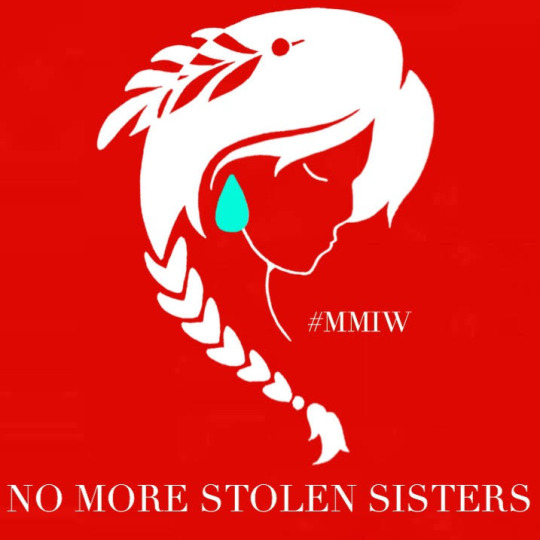
The issue of missing and murdered Indigenous women is a devastating tragedy that has plagued Indigenous communities for decades. Despite being deeply rooted in the history of colonization, it remains an ongoing crisis that demands immediate attention. This blog post aims to shed light on this heartbreaking reality and urges society to acknowledge, address, and support initiatives aimed at ending the violence.
A Historical Context:
To truly understand the gravity of the situation, we must recognize the historical context in which this epidemic has unfolded. Since European colonization began in North America, Indigenous women have faced systemic discrimination, marginalization, and violence. These injustices persist today as a direct result of centuries-long oppression and the erosion of Indigenous cultures.
Disturbing Statistics:
The statistics surrounding missing and murdered Indigenous women are both shocking and disheartening. According to a 2016 report by the National Crime Information Center (NCIC), there were over 5,700 cases of missing or murdered Indigenous American women recorded in the United States alone. Alarmingly, many believe these numbers may be underestimated due to underreporting or misclassification by law enforcement agencies.
Root Causes:
Numerous factors contribute to this crisis. Poverty, limited access to education and healthcare services, high rates of domestic violence within communities, institutional racism, inadequate law enforcement response, and human trafficking all play significant roles in perpetuating this cycle of violence against Indigenous women.
The Need for Awareness & Advocacy:
Raising awareness about this issue is crucial towards mobilizing action to end it. It requires educating ourselves and others about the plight faced by Indigenous women who continue to disappear or be victimized every day. Social media campaigns like #MMIWG (Missing and Murdered Indigenous Women and Girls) have played a pivotal role in bringing attention to their stories while demanding justice.
Government Action & Accountability:
Addressing this crisis necessitates a multi-faceted approach. Governments at all levels must take concrete steps to address the root causes of violence against Indigenous women, including improving collaboration between law enforcement agencies, enhancing victim services, and implementing culturally sensitive policies. Additionally, funding programs that empower Indigenous communities and strengthen support systems are essential for long-term change.
Community Empowerment:
Indigenous communities have been fighting tirelessly to protect their women and girls. Supporting grassroots organizations led by Indigenous people who understand the unique challenges faced by their community is crucial in eradicating this issue. By amplifying voices from within these communities, we can ensure that culturally appropriate solutions are implemented while fostering healing and resilience.
The missing and murdered Indigenous women crisis demands urgent attention from society as a whole. Recognizing the historical context, understanding the systemic issues involved, advocating for awareness, holding governments accountable, and empowering affected communities are all integral components of bringing an end to this deeply entrenched tragedy.
To honour the lives lost and prevent future victimization, it is our collective responsibility to stand in solidarity with Indigenous communities and work towards creating a world where every woman feels safe, valued, and protected. Only through unity can we hope to achieve justice for the missing and murdered Indigenous women who deserve nothing less than our unwavering commitment to ending this heartbreaking reality once and for all.
#MMIW#MMIWG#Indigenous women#missing and murdered indigenous women#justice for our sisters#protect our women#no more stolen sisters#support Indigenous communities#stop the violence#raise awareness#honouring our ancestors#remember their names#break the silence#stand with Indigenous women
29 notes
·
View notes